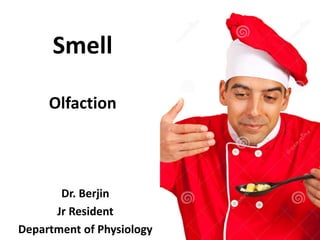
1. Smell.pdf
- 1. Smell Olfaction Dr. Berjin Jr Resident Department of Physiology
- 2. LEARNING OBJECTIVES • Olfactory Epithelium • Olfactory Sensory Pathway • Odor Detection Threshold • Abnormalities
- 3. • The flavor of foods is a combination of its taste and smell • Smell and taste receptors are chemoreceptors as they are stimulated by molecules in solution (mucus in the nose and saliva in the mouth)
- 4. Receptors for Olfaction • are the olfactory sensory neurons also called olfactory receptors • Olfactory sensory neurons are located in the yellowish pigmented olfactory epithelium (a specialized portion of the nasal mucosa) • It is situated in the roof of the nasal cavity near the septum
- 5. • How many olfactory sensory neurons? • about 50 million
- 6. Olfactory Epithelium • Bipolar olfactory sensory neuron • Supporting (sustentacular) cells • Basal stem cells
- 7. Olfactory Epithelium • Bipolar olfactory sensory neuron • Responsible for Olfactory transduction • Dendrites – forms 6 -12 cilia in nasal cavity • Axons – forms Olfactory bulb (CN I)
- 8. Olfactory Epithelium • Supporting (sustentacular) cells • Secrete Mucus • Odorants dissolves in mucus • Basal stem cells • Undergoes mitosis to generate new Olfactory epithelium
- 9. Olfactory Pathway • Olfactory sensory neurons are located in the olfactory epithelium • The axon of theses olfactory sensory neurons pierces the cribriform plate and enter the olfactory bulb
- 10. Olfactory Pathway - olfactory bulb • In the olfactory bulb, the axons synapse with the dendrites of the mitral cells and tufted cells and form globular synaptic units called called olfactory glomeruli • The olfactory bulb also contains periglomerular cells and granule cells
- 11. Olfactory Bulb Periglomerular cells Grannule cells Axon of Olfactory sensory neuron Mitral cells Tufted cells O l f a c t o r y G l o m e r u l i
- 12. Olfactory Pathway - olfactory bulb • The periglomerular cells are inhibitory neurons connecting one glomerulus to another • Granule cells make reciprocal synapses with the dendrites of the mitral and tufted cells • The mitral or tufted cell excites the granule cell by releasing glutamate, and the granule cell in turn inhibits the mitral or tufted cell by releasing GABA
- 13. Olfactory Pathway • The axons of the mitral and tufted cells pass posteriorly through the lateral olfactory stria to terminate in five regions of the olfactory cortex: • anterior olfactory nucleus, olfactory tubercle, piriform cortex, amygdala, entorhinal cortex
- 14. Olfactory Pathway • From the olfactory cortex (5 regions), information travels directly to the frontal cortex or via the thalamus to the orbitofrontal cortex • Conscious discrimination of odors is dependent on the pathway to the orbitofrontal cortex and frontal cortex
- 15. Olfactory Pathway • The pathway to the amygdala and hypothalamus (limbic system) is probably involved with the emotional responses to olfactory stimuli • The pathway to the entorhinal cortex is concerned with olfactory memories
- 16. Odorant receptors • Odorant receptors are located on the cilia of the olfactory sensory neurons, that project into the mucus • There are about 1000 different odorant receptors • They are G Protein Coupled Receptors • We can discriminate more than 10,000 different odors
- 17. ODOR DETECTION THRESHOLD • The olfactory receptors are very sensitive • Low concentrations of chemical that can be detected is called Odor detection threshold • Eg - Hydrogen Sulphide, Kerosene • Women > Men
- 18. Abnormalities of smell • Anosmia – Inability to smell • Hyposmia – Diminished olfactory sensitivity • Causes: - Simple nasal congestion, nasal polyps – Damage to the olfactory nerves eg fractures, tumors, infections – Ageing
- 19. Abnormalities of smell • Hyperosmia : Enhanced Olfactory Sensitivity Pregnant women are sometimes oversensitive to smell • Dysosmia : Distorted sense of smell – Sinus infections – Partial damage to the olfactory nerves